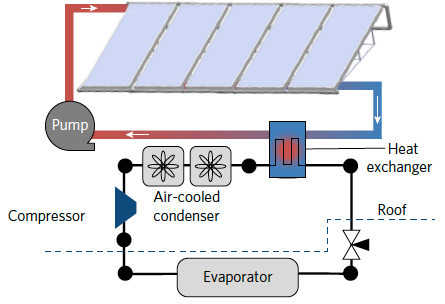A cooling system that works without electricity
September 6, 2017

Fluid-cooling panels being tested on the roof of a Stanford University building (credit: Aaswath Raman)
Stanford University scientists have developed a high-tech mirror-like optical surface that uses “radiative sky cooling” to dramatically lower the energy required for air conditioning and refrigeration.
The system cools water (flowing through pipes connected to an air-conditioning system) without requiring electricity by radiating excess heat from water into cold space. Panels covered in specialized optical surfaces reflect about 97 percent of the sunlight while simultaneously emitting the surface’s thermal energy through the atmosphere.
In a test on the roof of a Stanford University building, the panels were able to reduce the water temperature 3 to 5 degrees Celsius below ambient air temperature, allowing for a connected air conditioning system to lower its electricity use.

Modeling cooling system-level energy savings. The fluid cooling panels (top) reduce electricity consumption in cooling systems, such as an air-cooled condenser-based system used in the Las Vegas study. (credit: Eli A. Goldstein, Aaswath P. Raman and Shanhui Fan/Nature Energy)
The researchers modeled a cooling system of a two-story commercial building in a hot dry climate (Las Vegas) with this panel-cooled system installed. They found it would save 14.3 megawatt-hours of electricity in the summer months — a 21 percent reduction in the electricity used to cool the building.
The system would also reduce the significant water loss in cooling systems using evaporative cooling.
As the researchers, led by Shanhui Fan, professor of electrical engineering, write in a paper published in Nature Energy Sept. 4, “cooling systems consume 15% of electricity generated globally and account for 10% of global greenhouse gas emissions.”
They note that “with demand for cooling expected to grow tenfold by 2050, improving the efficiency of cooling systems is a critical part of the twenty-first-century energy challenge.”
The researchers have founded the company SkyCool Systems, which is working on further testing and commercializing this technology. They are focused on making their panels integrate easily with standard air conditioning and refrigeration systems, and are especially interested in cooling data centers.
This work was funded by the Advanced Research Projects Agency – Energy (ARPA-E) of the Department of Energy.
Abstract of Sub-ambient non-evaporative fluid cooling with the sky
Cooling systems consume 15% of electricity generated globally and account for 10% of global greenhouse gas emissions. With demand for cooling expected to grow tenfold by 2050, improving the efficiency of cooling systems is a critical part of the twenty-first-century energy challenge. Building upon recent demonstrations of daytime radiative sky cooling, here we demonstrate fluid cooling panels that harness radiative sky cooling to cool fluids below the air temperature with zero evaporative losses, and use almost no electricity. Over three days of testing, we show that the panels cool water up to 5 ∘C below the ambient air temperature at water flow rates of 0.2 l min−1 m−2, corresponding to an effective heat rejection flux of up to 70 W m−2. We further show through modelling that, when integrated on the condenser side of the cooling system of a two-storey office building in a hot dry climate (Las Vegas, USA), electricity consumption for cooling during the summer could be reduced by 21% (14.3 MWh).